|

| Build-Your-Own | Main Panel
| Dipole Woofer | Crossover/EQ
| Supplies |
| System Test | Design Models
| Prototypes | Active Filters
| Surround | FAQ |
The PHOENIX project from the year 2000
is obsolete and no longer supported. The information on the following pages is
an introduction to open-baffle loudspeaker systems and highly educational. The
PHOENIX evolved via the ORION into the LX521.4.
Use of a printed circuit board greatly simplifies the
construction of the electronics for the PHOENIX or the addition of a dipole woofer
to an existing system (FAQ10, 15). Stuffing the leads of the components through the correct
holes of the board is made easy by having a silk screened designation for each circuit element and a corresponding match with the parts list.
You solder the leads to pre-tinned pads on the
backside of the board. The board is then fully functional since input and output
connectors are mounted on the board.
All this saves you a major amount of time - even when it
takes about 4 hours to fully load and solder one board - over constructing
your own point-to-point wired electronics or designing your own printed circuit
board.
And while it helps you with building an exceptional loudspeaker system, selling
the
printed circuit board gives me some compensation for development expenses,
for the extensive information that I provide you with and keeps the pages free
of flashing advertisements to pay for the site.
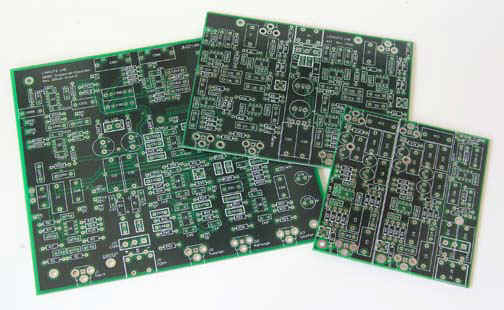
ORION-ASP, MT1 and WM1 printed circuit boards
The latest version of my printed circuit boards is the
ORION Analog Signal Processor. It is a universal circuit topology for building a
wide range of 3-way crossover/equalizers. It is used for PHOENIX and ORION but
also available for your own speaker development, be it dipole or box.
The PHOENIX speaker system was introduced in 2001. Its
construction and the design philosophy behind it is fully described in the pages
of my website. The construction plans are newly revised and incorporate the
changes that have occurred for various reasons. I now recommend the Peerless
12" XLS driver, 830500, for the dipole woofers and a 24 dB/oct crossover
between woofer and midrange. Midrange and tweeter choices continue to be the Scan Speak
21W/8554 and D2905/9700 drivers. If you want to use different drivers, then the
ASP is flexible enough to accommodate them. Any necessary filter circuit changes
are up to you and I cannot give you specific help over what you can find on this
website and on my Archive CD.
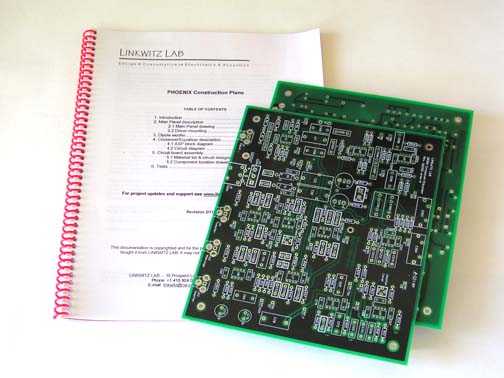
The PHOENIX documentation provides:
- Schematic of Crossover/EQ circuit. All component values and circuit designations.
- Parts list with order numbers for Digi-Key and Mouser
- Printout of silk screen for parts location
- Main panel drawings and assembly description
- Dipole woofer drawing
- ASP description and assembly notes
- Frequency response of ASP
- Circuit board test and speaker test notes
The ORION ASP printed circuit board that is used for the
PHOENIX
project has the following features :
- Woofer, mid, and tweeter equalization circuitry
for a single channel with dc supply filtering
- 8" wide along the connector side by 7" tall,
0.062" FR4
- Top silk screen with component designations
- 2 layer pcb with top layer ground plane, 1 oz. Cu, 50 mil traces, plated through
holes, solder mask top and bottom
- DIN power connector and 4 RCA phono connectors
- Connection pads for dc power to other boards, power
indicating LED
- Input RFI filter
- Tweeter and woofer 24 dB/oct crossover filters and
equalization
- Tweeter and midrange offset delay
- Woofer shelving filter, Linkwitz Transform
- DC supply filter
The two ASP printed circuit boards for a PHOENIX
No
longer available from Linkwitz Lab
You can purchase the ORION ASP
printed circuit board by itself for your own 2-way or 3-way active
loudspeaker project design. From the block diagram
and its application to the ORION you should be able to tell the wide range of signal processors that can be built
with it. The circuit board comes only with the documentation that is necessary
for using it.
- ASP block diagram
- Circuit schematic with component designators, but
without component values
- Component layout on the circuit board
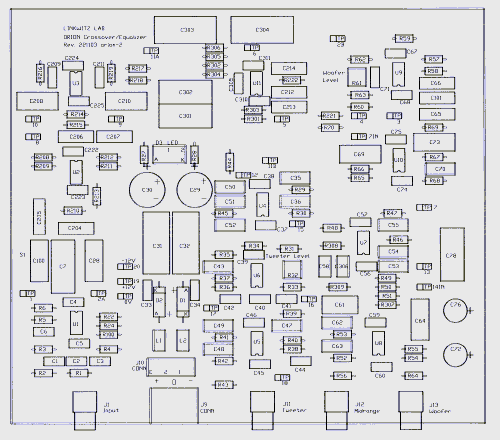
The circuit board is meant to simplify your own ASP
assembly when you know how to design an active crossover/equalizer. I cannot
provide you with more help than what you can find on my website Archive
CD and the Active filters pages. Purchase the PHOENIX Construction Plans+ if you are learning to build
active speakers.
Two ORION ASP printed circuit boards are available for
€100 plus shipping and PayPal fees.
WM1 printed
circuit board
The WM1 printed circuit board allows the
construction of a variety of active line-level filters for loudspeaker equalization.
In particular, it provides dipole equalization and the Linkwitz Transform. For the design of the filters and to determine
component values follow the outline given on the Active
Filters page and on the Archive CD.
The WM1 has the following features:
- Circuitry for two channels
- 4.2" wide along the connector side by 4.6"
deep,
0.062" FR4
- Top silk screen with component designations
- 2 layers, top layer ground plane, 1 oz. Cu, 50 mil traces, plated through
holes, solder mask top and bottom
- DIN power connector and 4 phono connectors (2-in,
2-out)
- Connection pads for dc power to other boards
- Weight 40 gram (1.5 oz)
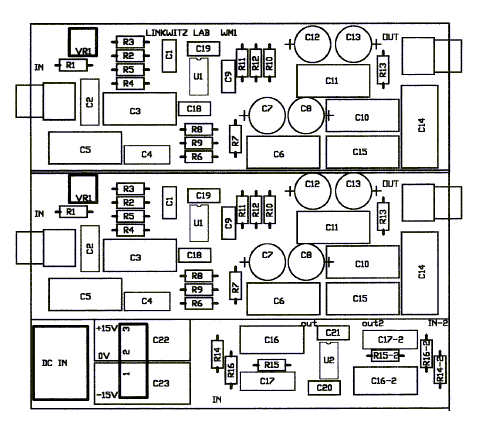
The WM1 comes with the following documentation package:
- General schematic with component designations
- Printout of silk screen for parts location
- Example circuit schematics with component values and
designations
- Parts list for one example with order numbers for Digi-Key and Mouser
- +/-12 V power supply recommendation
The WM1 is available for $30 plus shipping and
PayPal fees OBSOLETE
MT1 printed
circuit board
The MT1 printed circuit board allows the
construction of a variety of active line-level filters for loudspeaker equalization.
In particular, it provides crossovers, baffle step and delay compensation for a
2-way active speaker. For the design of the filters and to determine
component values follow the outline given on the Active
Filters page and on the Archive CD.
The MT1 has the following features:
- Circuitry for two channels and dc supply filtering
- 6.25" wide along the connector side by 4.6"
deep,
0.062" FR4
- Top silk screen with component designations
- 2 layers, top layer ground plane, 1 oz. Cu, 50 mil traces, plated through
holes, solder mask top and bottom
- DIN power connector and 6 phono connectors
- Connection pads for dc power to other boards
- Weight 70 gram (2.5 oz)
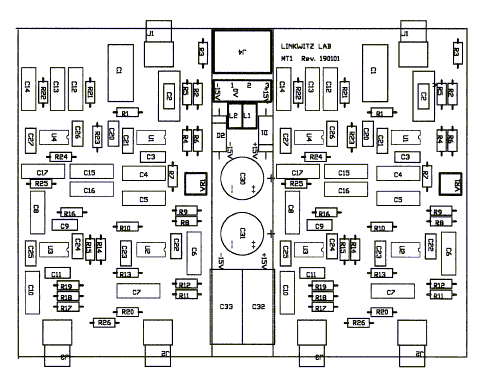
Both boards come with the following documentation package:
- General schematic with component designations
- Printout of silk screen for parts location
- Example circuit schematics with component values and
designations
- Parts list for one example with order numbers for Digi-Key and Mouser
- +/-12 V power supply recommendation
The MT1 is available for $40 plus shipping and
PayPal fees OBSOLETE
==========================================
Contact me first, if you are considering commercial
use of the printed circuit boards.

| Build-Your-Own | Main Panel
| Dipole Woofer | Crossover/EQ
| Supplies |
| System Test | Design Models
| Prototypes | Active Filters
| Surround | FAQ |
|